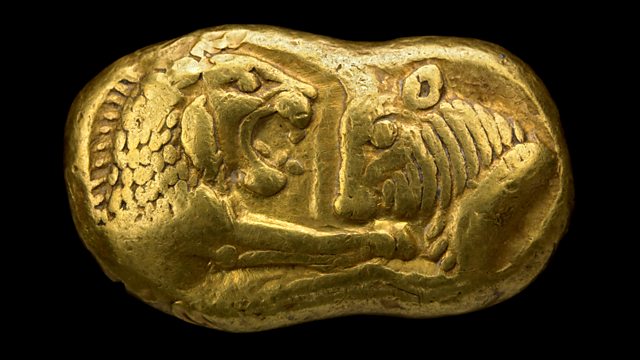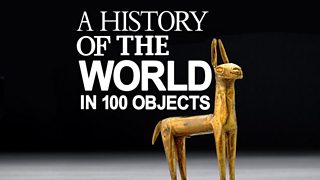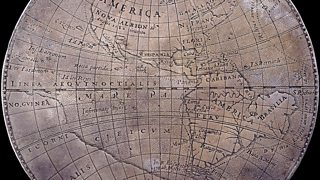Gold Coin of Croesus
Neil MacGregor continues his world history told through objects at the British Museum with the world's first proper coins that made King Croesus so rich
The history of the world as told through one hundred objects from the British Museum. This week Neil MacGregor, the Museum's Director, has been looking at the collapse of old regimes and the emergence of new powers from the Middle East to China. In today's programme, he describes how a powerful new state finds a dramatic way to help run its increasingly complex economy and trading networks - using coins.
Croesus was a king in what is now Western Turkey and his kingdom was called Lydia. It's remarkable that over two thousand years later we still have an expression that celebrates his wealth. Neil MacGregor considers how money, in the form of coins, first came about and describes the (hugely complex) methods of creating them. And whatever happened to Croesus?
Last on
More episodes
Next
You are at the last episode
![]()
A History of the World in 100 Objects - objects related to money, trade and travel.
About this object
Location: Made in Modern Turkey
Culture: Ancient Middle East
Period: About 550 BC
Material: Gold
��
These are some of the world's first coins, produced in Lydia, western Turkey, over 2500 years ago. The lion on this coin is seen as a symbol of royalty. The two deep impressions were created by a hammer, used to punch the image of the lion and bull into the blank coin. Lydia was renowned for its wealth and its last king, Croesus, was immortalized in the saying 'as rich as Croesus.'
Why did people invent money?
Cities and empires managed without coins for over 2000 years. Electrum (gold and silver mixture) was used for the first coins, but coinage gained popularity when gold and silver coins were introduced. Coinage probably developed in Lydia because it was a trading centre and possessed large gold supplies. Before coins, payments were made with metal bullion or by barter. To establish its value metal was checked for purity and weighed. The Lydians minted coins of consistent weight and purity to speed up transactions.
Did you know?
- Lydian gold came from the river in which King Midas supposedly washed away his ability to turn all he touched into gold.
How did they prove gold was pure?
By Paul Craddock, Scientist, British Museum
��
Our concept of coinage relies on being able to guarantee the weight and purity of the metal in a coin.
The simplest and oldest tool to determine the purity of gold was the ‘touchstone’. A gold coin (of unknown purity) is rubbed against a dark stone creating a streak. Then further streaks are made with pieces of gold with known amounts of silver (or copper) and the colours of the streaks are compared until an exact colour match to the unknown is obtained. This match indicates that both are of the same purity.
The principles of determining the density of gold and silver relative to water (known as their “Specific Gravity”) was famously discovered by the ancient Greek mathematician, Archimedes, in his Eureka moment around 250 BC. But it was not generally used for measuring the purity of gold before the sixteenth century.
Gold and silver are often found mixed together, and for this alloy “fire assay” was used to determine the proportion of gold.
Thin sheets of the metal are heated in a pot containing salt and brick dust. When red hot, the salt vapour attacks the silver present in the gold. This forms silver chloride, which soaks into the brick dust, leaving the pure gold. Again the difference between the weight of the original and its weight after the fire assay indicates the purity of the original gold.
These ancient methods were used almost to the present day, but were improved over the years, with acids replacing salt for example.
All these methods determined the gold content, but they did not establish the proportions of the silver and copper added, or identify any trace elements present. This changed in the twentieth century with the introduction of modern methods.
One method, X-ray fluorescence analysis (XRF), used today involves bombarding the sample with X-rays, which cause the metal to emit secondary X-rays characteristic of the elements present. Another method is Inductively Coupled Plasma Spectrometry (ICP), in which the sample is vaporised and at these very high temperatures the elements can be identified by the spectrum produced.
In many parts of the world, however, the most trusted method of determining the purity of gold is still the touchstone.
What’s it worth?
By Amelia Dowler, Curator, British Museum
��
The first coins were probably invented because they were essentially more convenient pieces of bullion and, unlike relying on the exchange of common goods like grain they were non-perishable.
It is often thought that the use of coins was started by the Lydian king Croesus. In fact, he probably reigned in about 561—547BC, while the earliest coins known from this area, made from electrum, are from around 100 years earlier. Electrum is a naturally occurring mixture of gold and silver. Though the ratio of gold to silver in electrum naturally varies, the Lydians made it regular to have a more standardised metal for coinage.
Coins could be made to fit a fixed weight standard and, to maintain a city or state’s reputation, they were made of good metal (in other words, they were not ‘watered down’ with the addition of base metals such as copper or lead). They also displayed an image representing the city or state so for the first time people could see where bullion (as a coin) had come from. Later on inscriptions were added to these designs.
The ancient Greek author Herodotus tells us that the Lydians were the first people to mint separate gold and silver coins, and it is these which are associated with the Lydian king, Croesus. This bimetallic currency had many advantages.
Silver was more widely available than gold and with a lower value could be used for smaller transactions and was therefore better in the marketplace. So, it was silver coinage which gained rapidly in popularity and, during the sixth century BC, mints opened in Greek cities across the Mediterranean. Though most popular in Greek cities and colonies, coins were also minted in non-Greek areas. Areas not producing coins at all are often found from archaeological evidence to have been using coins brought in from elsewhere.
The idea of coinage spread and by the beginning of the fifth century BC, mints were in operation from South Italy and Sicily all across the Mediterranean to the Middle East.
Large silver coins familiar from museum displays would have been very high value items in the market place. One of the more famous examples is the Athenian tetradrachm (four drachmas) which was about 17.2g of silver. In fifth century BC Athens that would buy 30-40kg of wheat. Beneath the highest denominations such as these, the coins got smaller to represent smaller values. This is a system based on the intrinsic value of the metal.
Today we use a token currency, where the value is guaranteed by the state and not by the value of the metal used in the coins. Small silver denominations became inconveniently small however, and gradually lower value copper alloys or bronze were used as the coins could then be larger.
Often these bronzes remained in local circulation, but gold and silver coins could still be treated as bullion no matter how far from the mint they travelled – and this is still the case today.
Transcript
Broadcasts
- Fri 19 Feb 2010 09:45�鶹�� Radio 4 FM
- Fri 19 Feb 2010 19:45�鶹�� Radio 4
- Sat 20 Feb 2010 00:30�鶹�� Radio 4
- Fri 21 Aug 2020 13:45�鶹�� Radio 4 FM
Featured in...
![]()
Money, Trade and Travel—A History of the World in 100 Objects
A History of the World in 100 Objects - objects related to money, trade and travel.
![]()
Leaders and Government—A History of the World in 100 Objects
More programmes from A History of the World in 100 Objects related to leaders & government
Podcast
-
![]()
A History of the World in 100 Objects
Director of the British Museum, Neil MacGregor, retells humanity's history through objects





